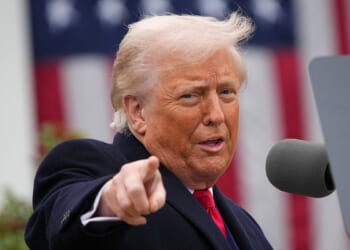When the White House invoked the “Immortal Chaplains” to illustrate the history between the United States and Greenland, it touched on a theme emerging in the second Trump administration: the importance of courage.
On Feb. 3, 1943, the American steamship SS Dorchester embarked with 902 souls—soldiers, merchant seamen, and civilians—bound for a U.S. Army base in southern Greenland to support the buildup of military personnel during World War II. The ship’s captain ordered those on board to sleep in their uniforms and life jackets in case of an attack by German submarines, but many disregarded the order because of heat from the ship’s engine.
Just after midnight, a U-boat’s torpedo slammed into the Dorchester’s starboard side below the water line. Four Navy chaplains—a rabbi, a Methodist minister, a Catholic priest, and a Protestant reverend—gave up their own life vests and guided panicked crew members to the lifeboats. The Dorchester sank in 20 minutes.
One of the 230 survivors later recalled what he saw as he swam away from the ship: “The bow came up high and she slid under. The last thing I saw, the four chaplains were up there praying for the safety of the men. They had done everything they could.”
Courage means feeling fear but behaving in a way that is noble and good, as the chaplains did when they acted on their deepest convictions aboard the Dorchester. Donald Trump once wrote that courage is not the absence of fear but “the ability to act effectively, in spite of fear.”
In 2016, Trump showed moral courage when he spoke the truth to American voters: A parasitic “establishment” of political and corporate interests had been exploiting our workers, farmers, and soldiers. When Trump challenged 16 opponents in the Republican primary, he exposed untruths in a conservative orthodoxy passed down from Ronald Reagan through George W. Bush. Establishment foes hounded him with investigations and impeachment proceedings throughout the four years of his presidency, but Trump refused to compromise his principles or check his ambition to “make America great again.”
Emboldened by Joe Biden’s inauguration in 2021, the establishment connived to use the 14th Amendment to prevent Trump from running for president a third time. They leveled charges against him in two federal district courts, tried him in a New York state court, and indicted him in Georgia for alleged RICO Act violations.
Though Trump was unbowed, his campaign manager, Susie Wiles, was concerned: “I just worry that if they can’t get him this way, they’ll try to kill him.” And that almost happened on July 13 at the fairgrounds in Butler, Pennsylvania, when an assassin’s bullet grazed Trump’s ear.
Where Trump modeled courage, the establishment shows only cowardice—their decade-long effort to destroy Trump has been prosecuted from the shadows, hiding behind the anonymity that bureaucratic power affords. They falsely claimed that Trump “colluded” with Vladimir Putin and Russia. They used a cloak-and-dagger plan to scuttle the Supreme Court nomination of Brett Kavanaugh in 2018. And, in 2022, someone leaked a copy of the Dobbs decision overruling Roe v. Wade. In spite of Chief Justice John Roberts’ promise, the leaker remains unidentified and unaccountable.
Some say that Trump’s opponents exemplify courage in their bold attacks on his character and reputation. But talk doesn’t make them courageous, least of all because it costs them nothing. Their admonitions are purely performative means to curry favor with the media and the establishment at large, which are viciously opposed to Trump’s reforms.
There is nothing courageous about yelling “F–k Trump” into a microphone. Whatever force it has in the political sphere depends on showing that the saying is accompanied by a doing. Trump’s been talking tough for years and backs it up by action of some kind. In the moment that he rose to his feet in Butler, with his face bloodied and yelling, “Fight! Fight! Fight!,” he gave the final proof that he’s more than a tough talker.
Biden’s presidency is a rich example of cowardice: Insiders worked for years to conceal that the sitting president was incapable of executing the duties of the office. In the book “Fight: Inside the Wildest Battle for the White House,” longtime political reporters Jonathan Allen and Amie Parnes pull back the curtain on Biden’s presidency, detailing how his staff stage-managed a declining president and hid his impairment from the American people. Biden “lived in bubble wrap inside bunkers,” the authors write.
Though “the signs of decline were clear to anyone who was willing to see them,” Biden’s inner circle believed that “no one walks away from the house, the plane, the helicopter,” so, onward they went. When the scam was exposed at the presidential debate last June, the power players in Washington again retreated to the secrecy of the back room and hatched a scheme to cede the delegates that Biden had secured to nominate a candidate of their choice rather than the people’s choice.
For decades, presidents talked about moving the U.S. embassy in Israel from Tel Aviv to Jerusalem, but no one did until Trump. For years, Chuck Schumer, Nancy Pelosi, and Bernie Sanders called for tariffs to restructure world trade. But when Trump did what he said he would do and imposed tariffs? That was all it took for the same people to discover their opposition to tariffs.
The cowardice of Biden and the leading lights in the Democratic Party contrast sharply with the new administration. Trump and many others have gambled their reputations, fortunes, and future interests on a bold but polarizing agenda. They face the American people, every day, openly and fearlessly.
For Trump, the most important quality for aides and Cabinet members is not loyalty but courage—and the willingness to pay a price for things that matter.
We publish a variety of perspectives. Nothing written here is to be construed as representing the views of The Daily Signal.
This article was originally published by RealClearHistory and made available via RealClearWire.








